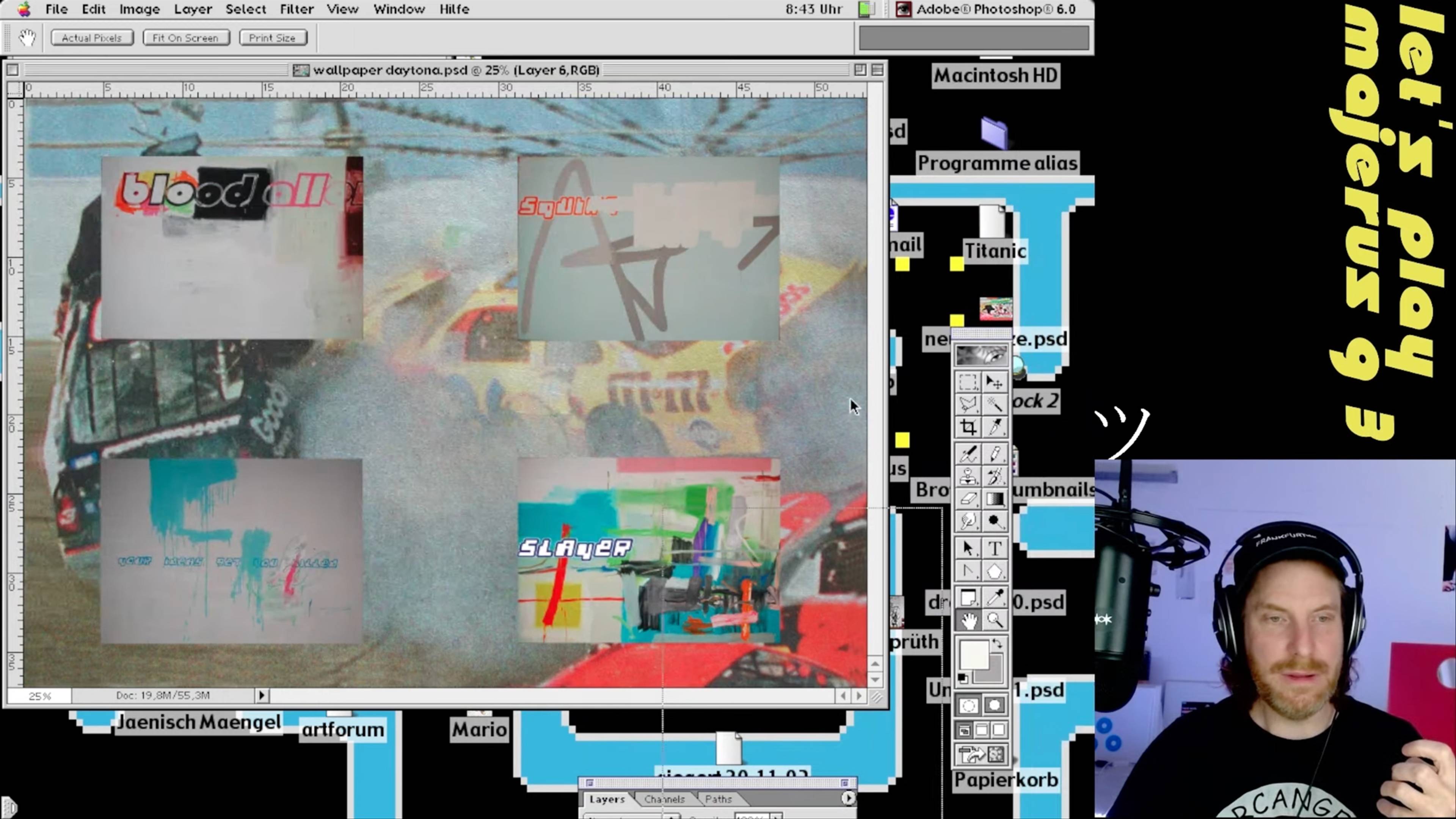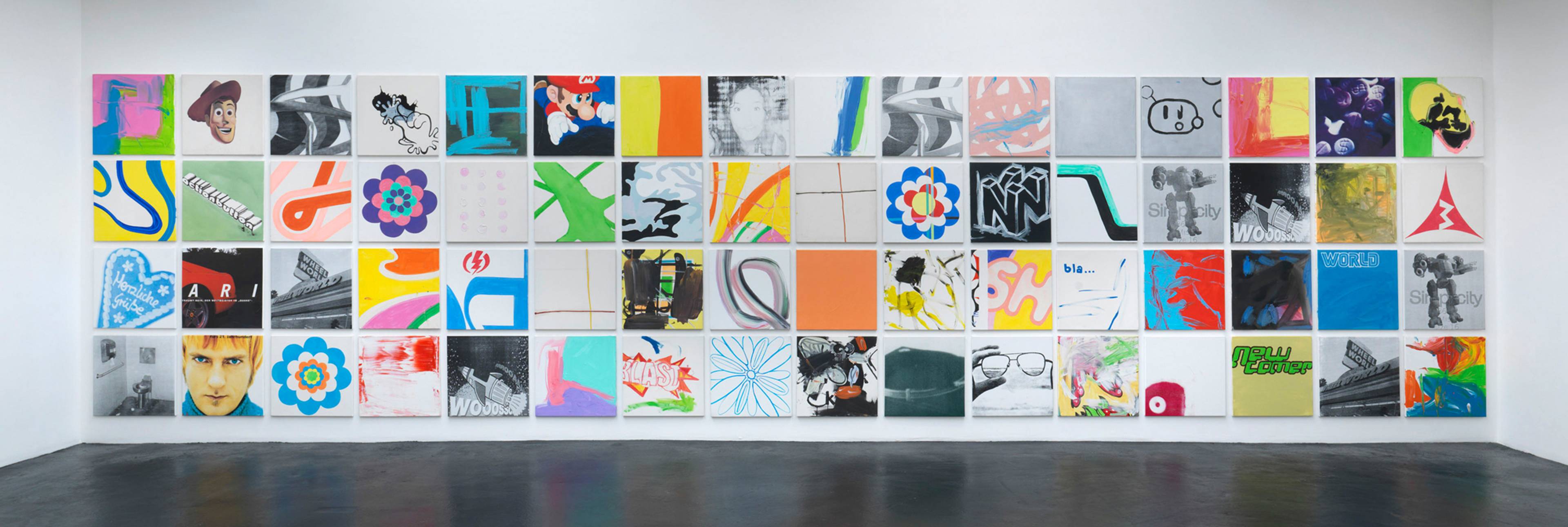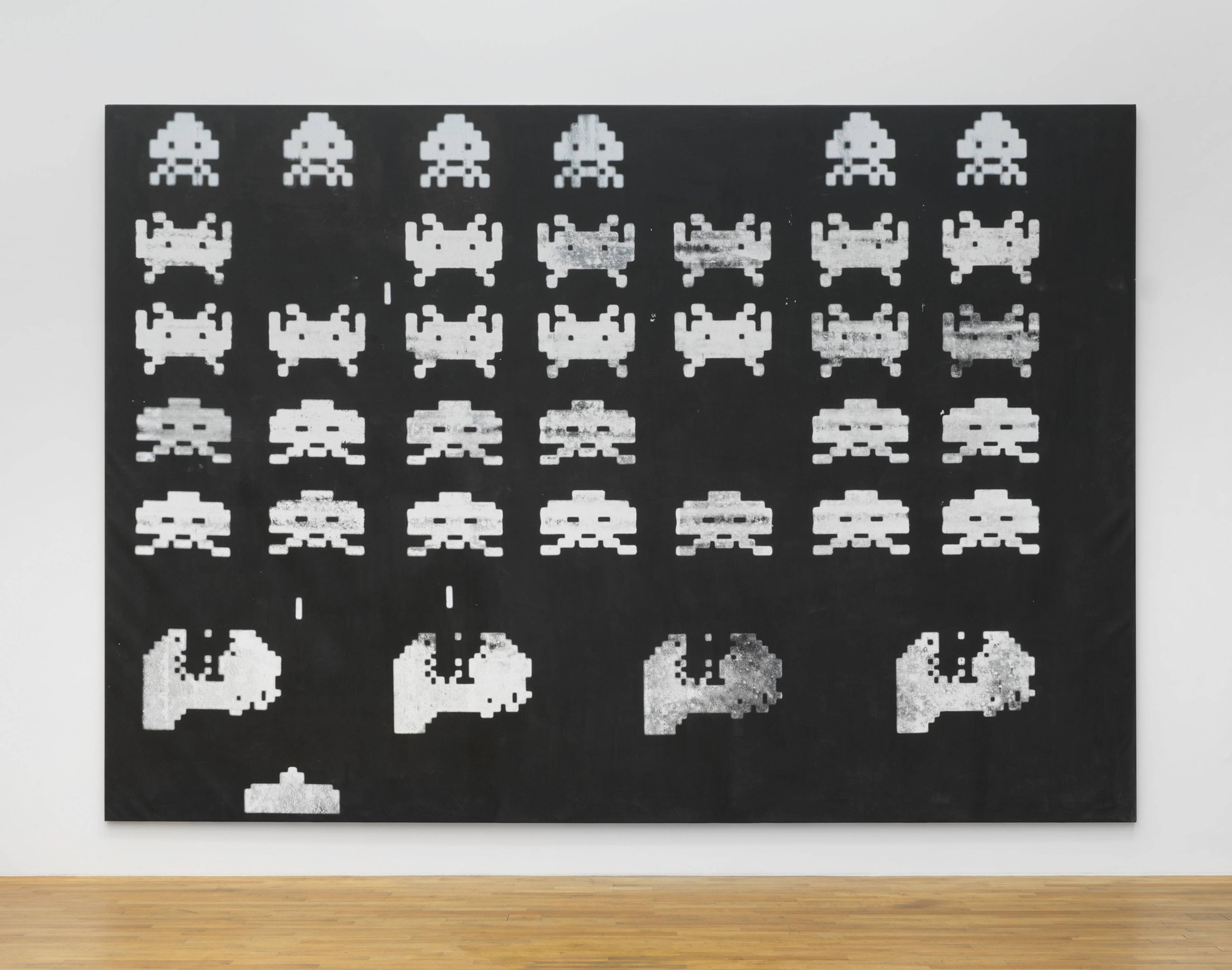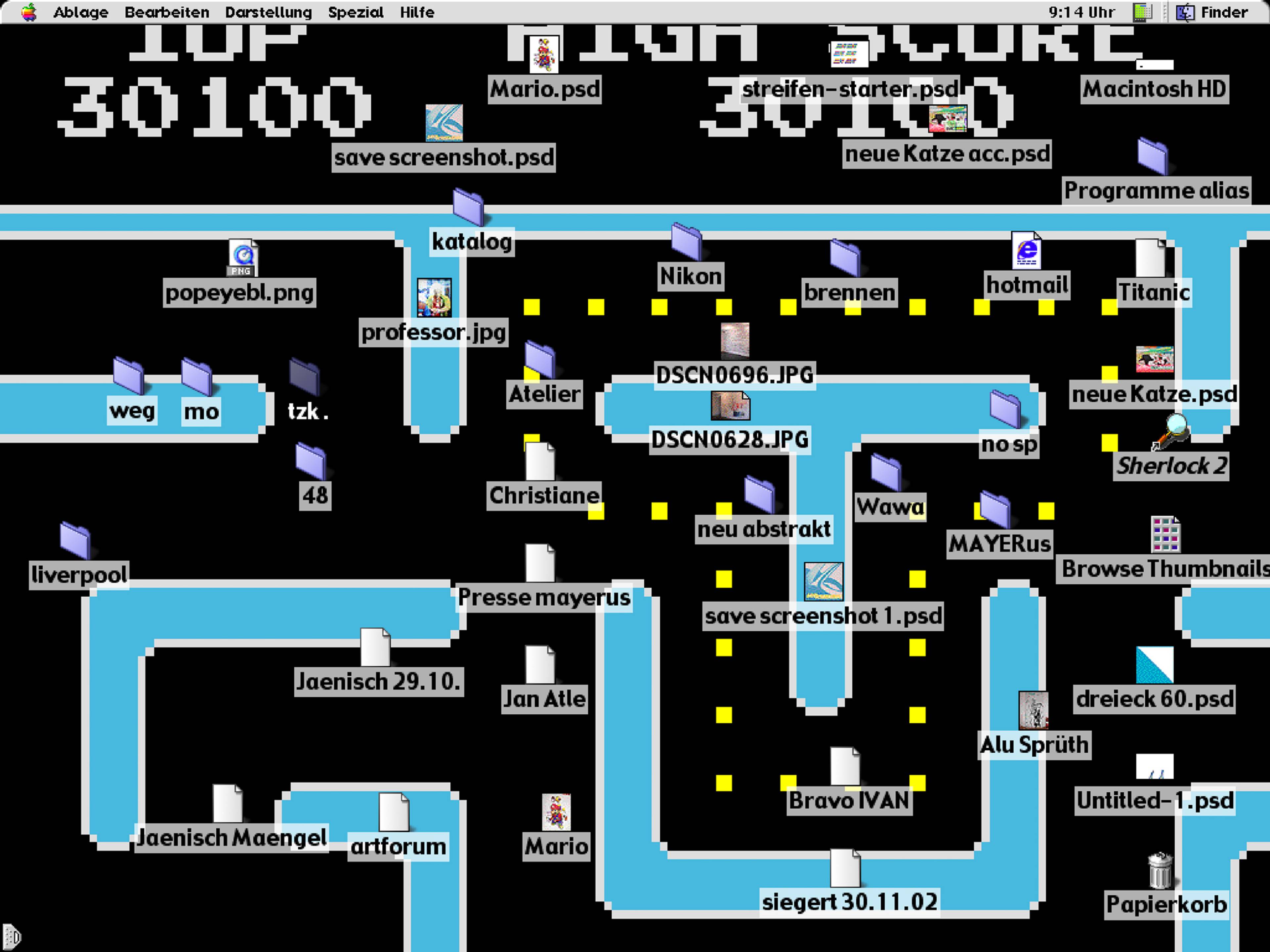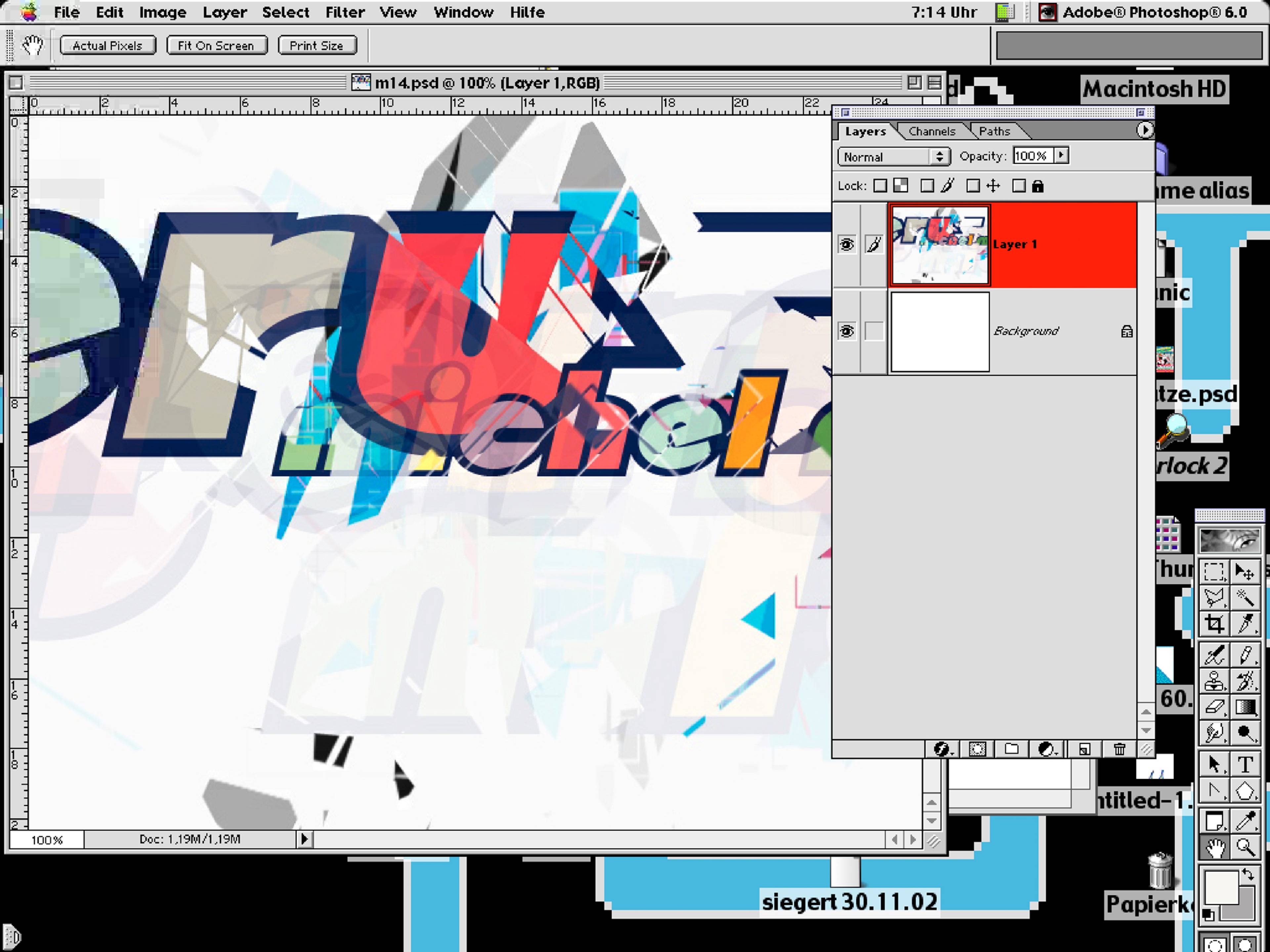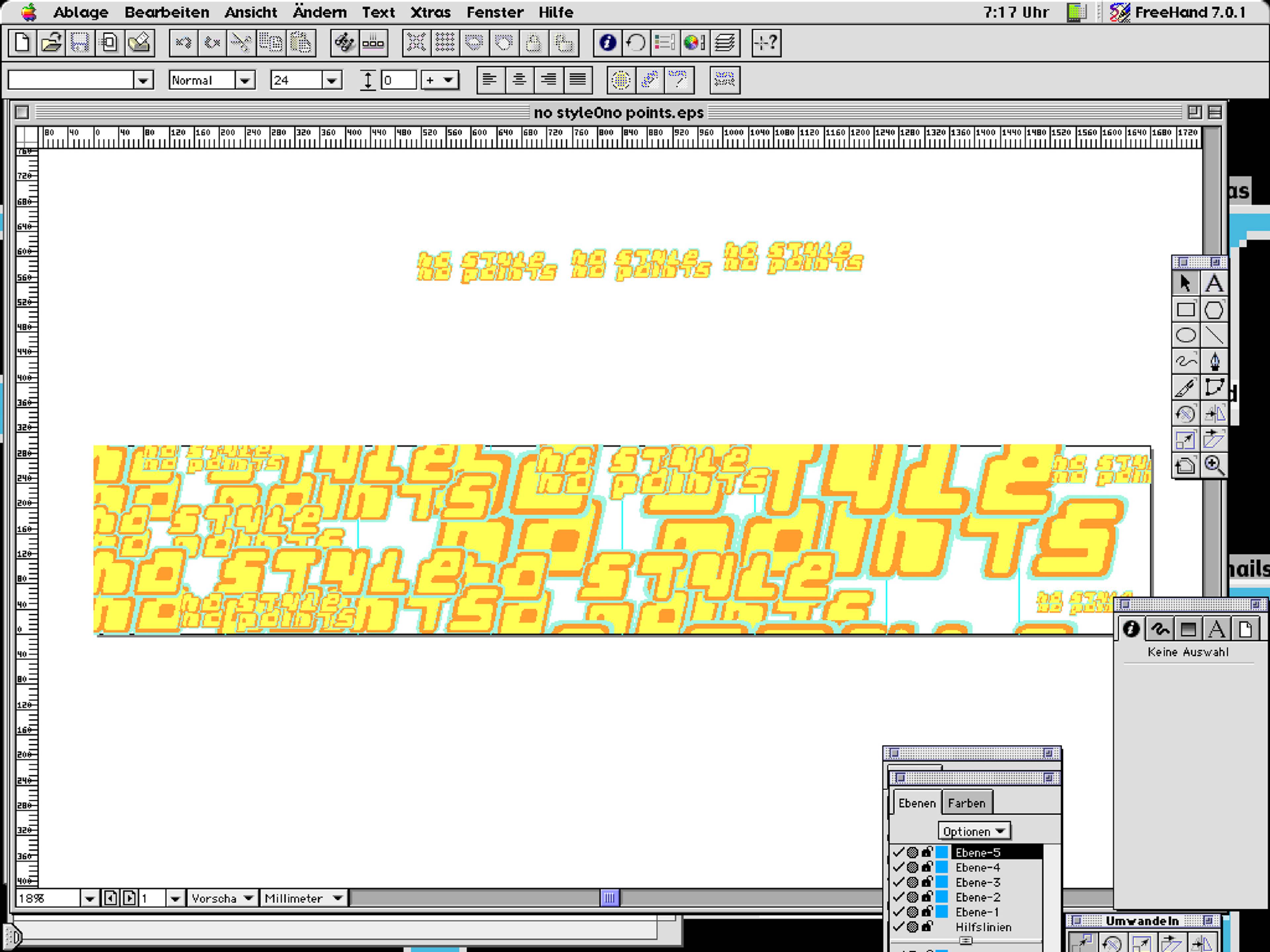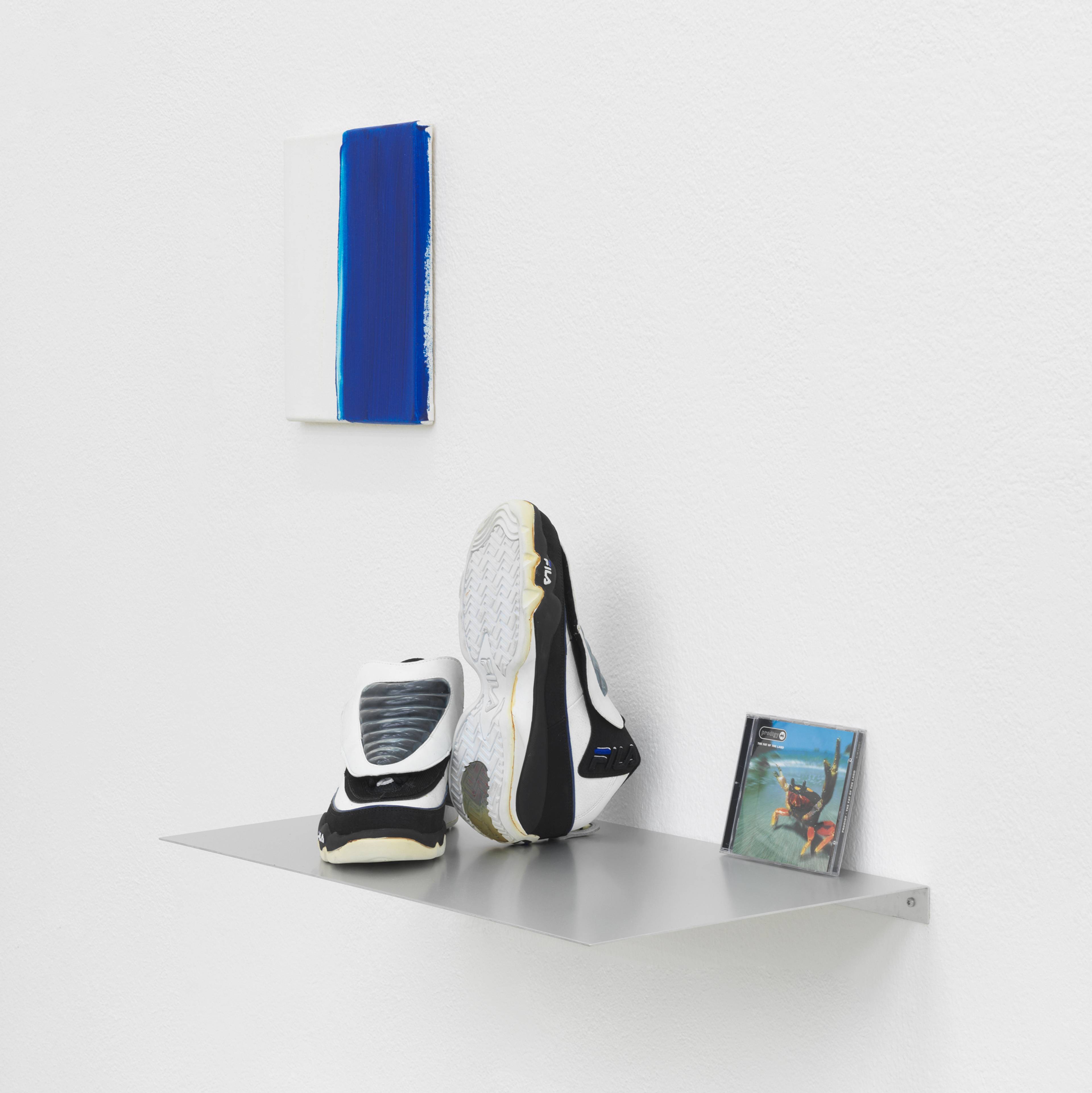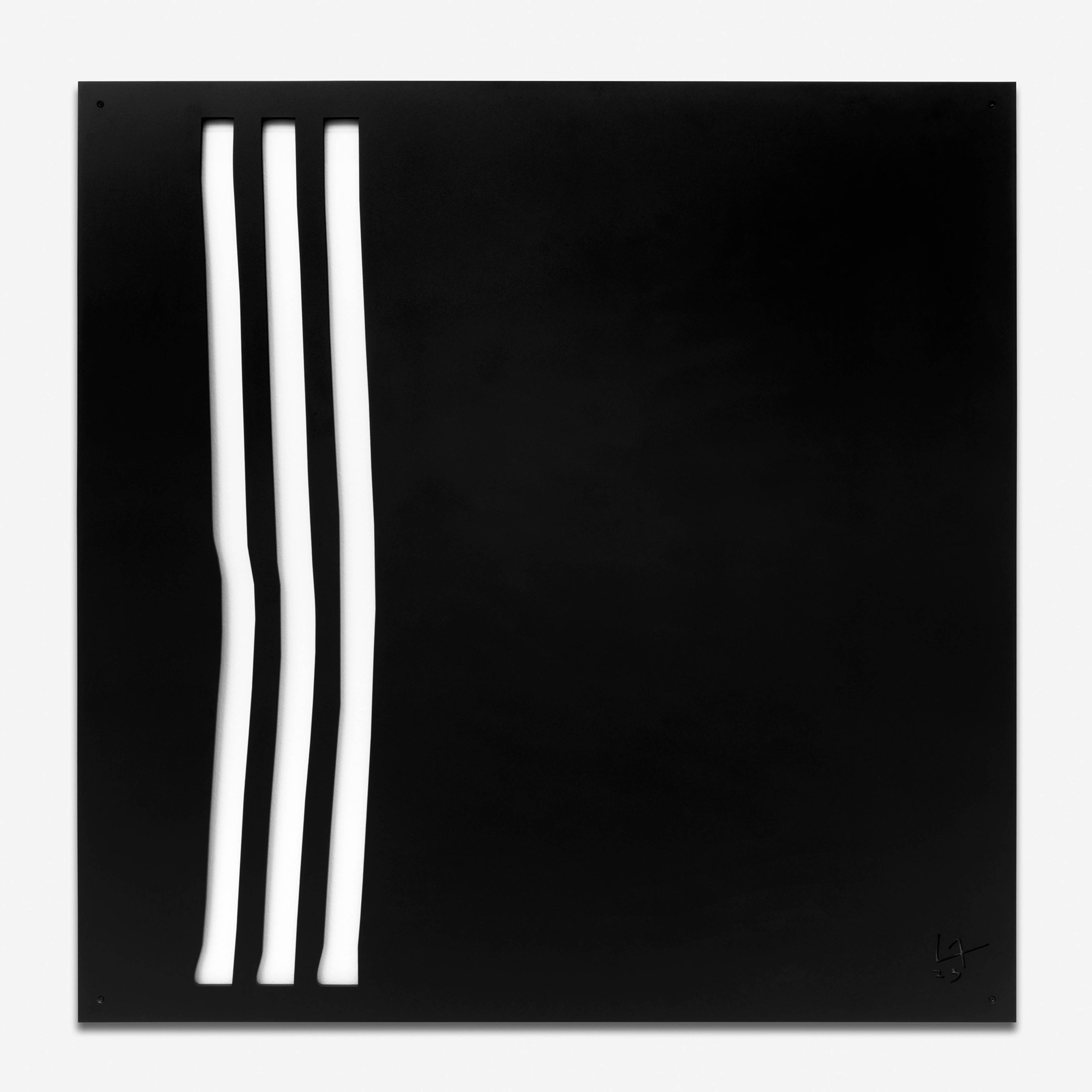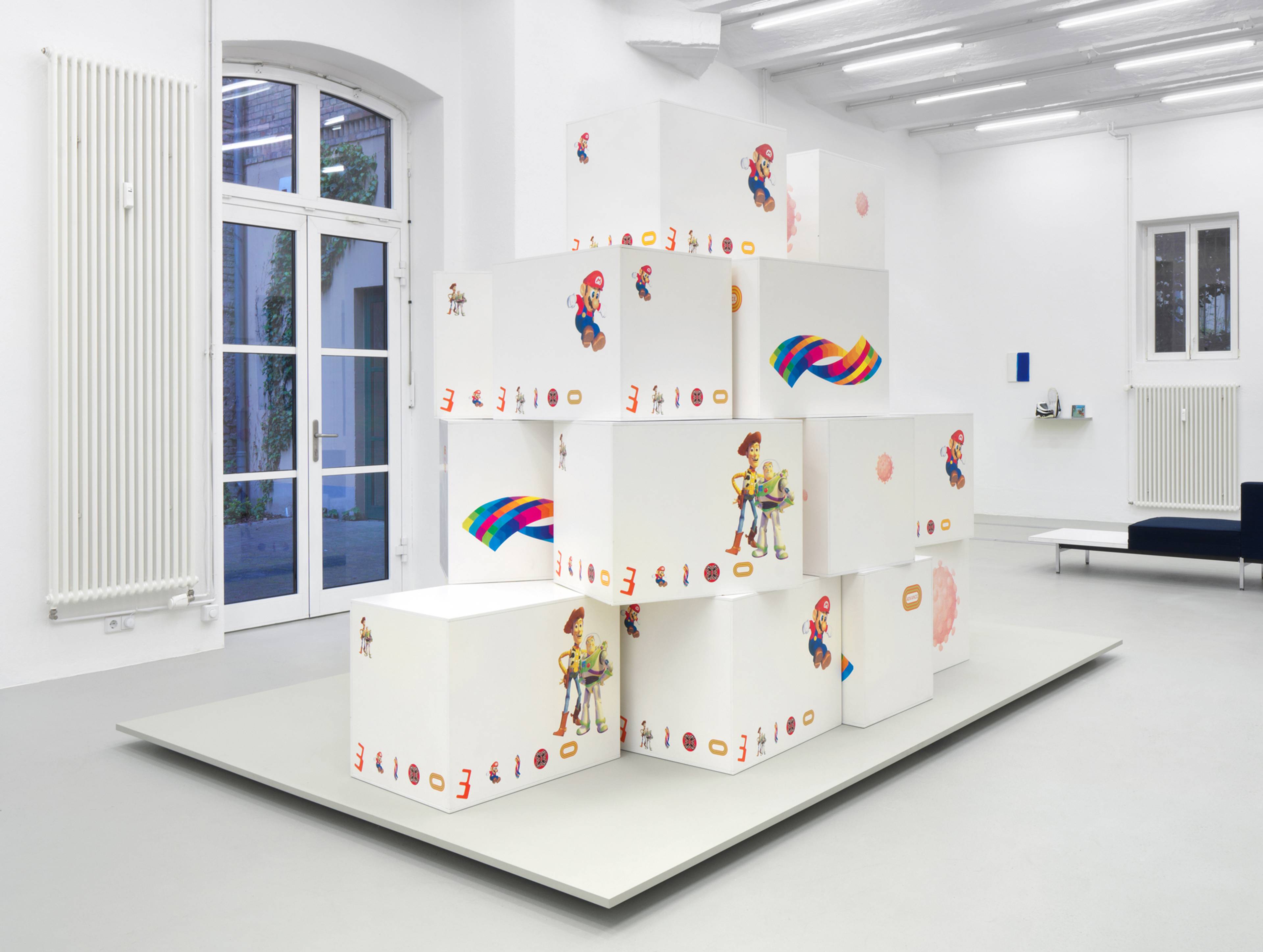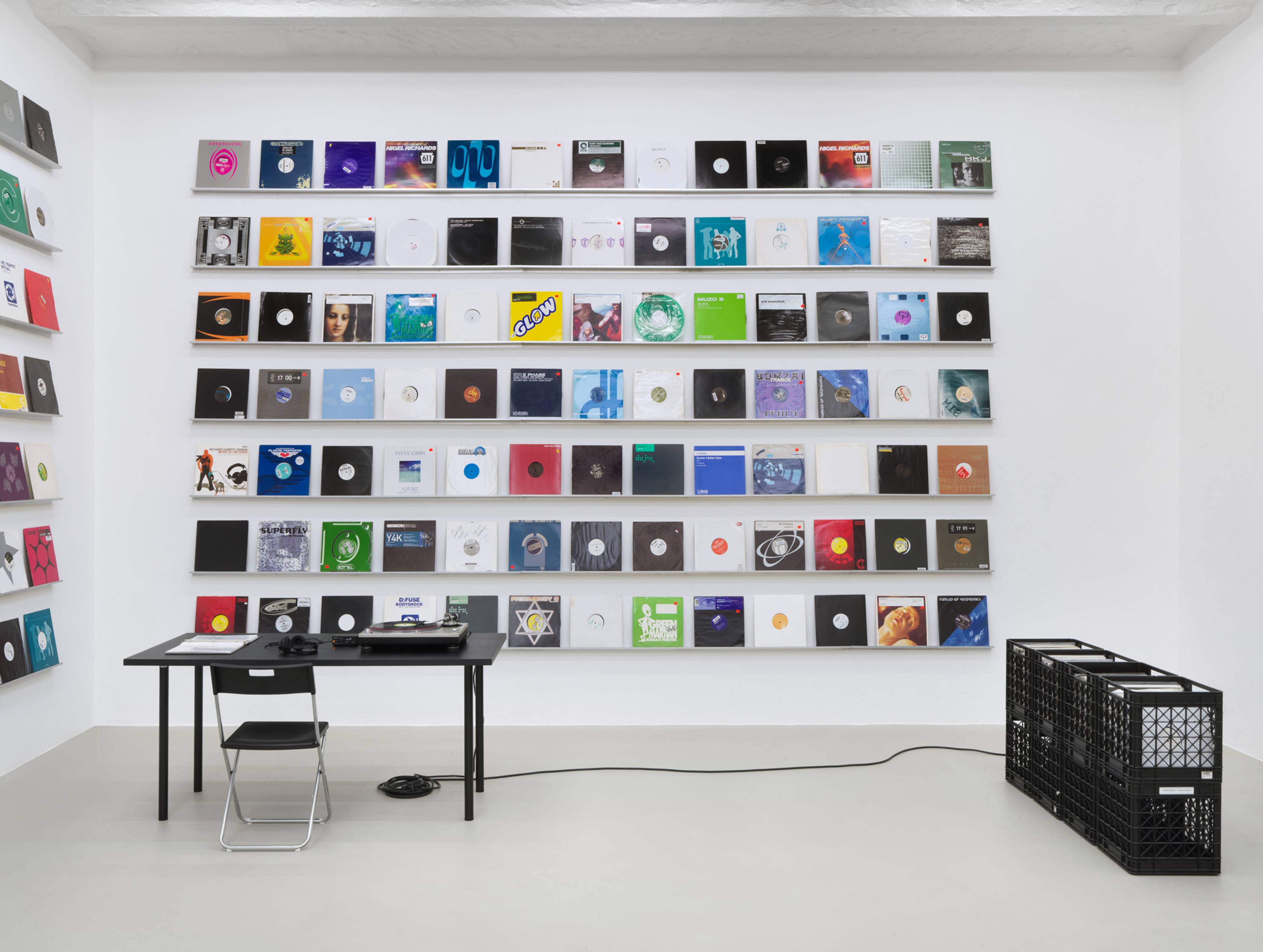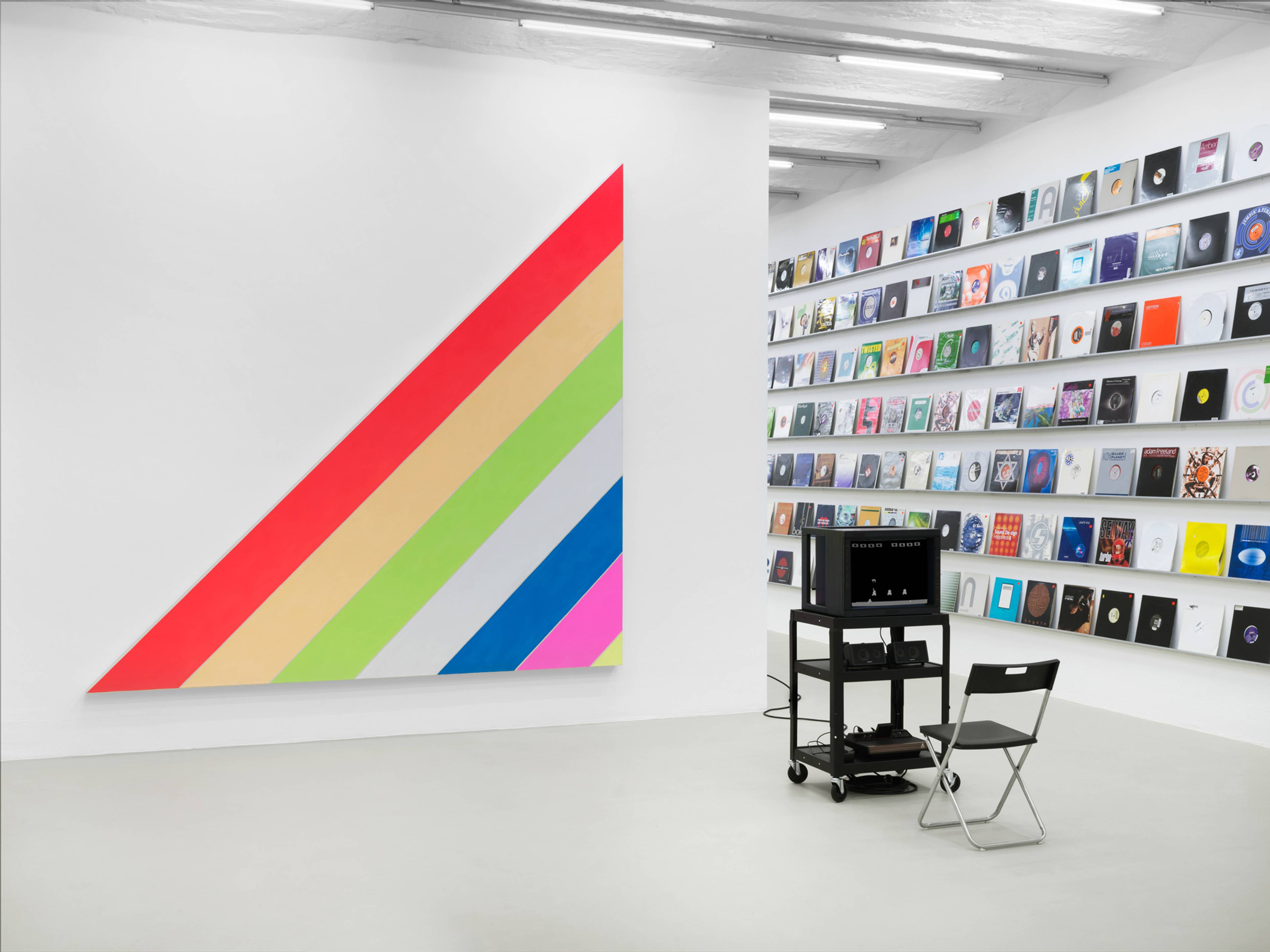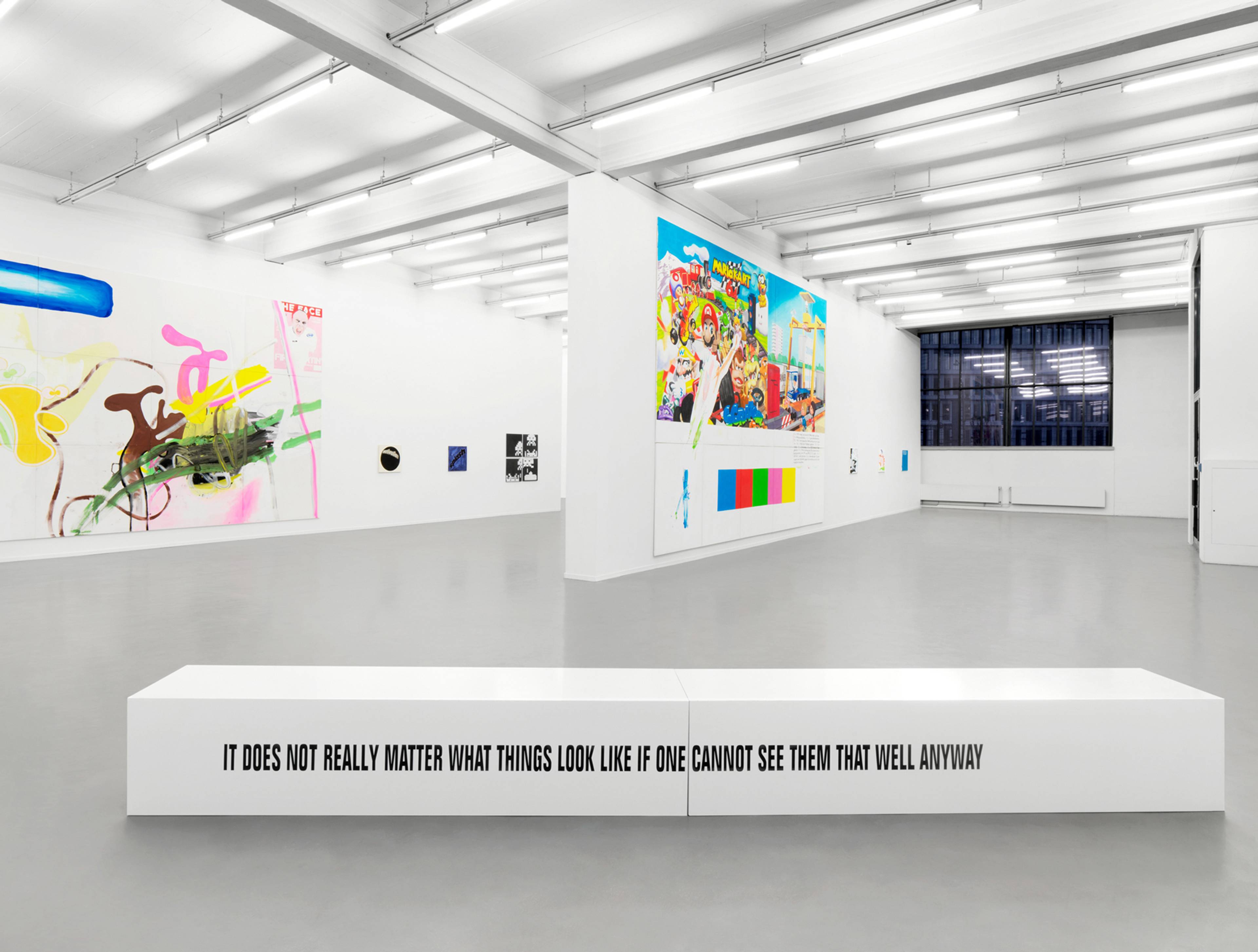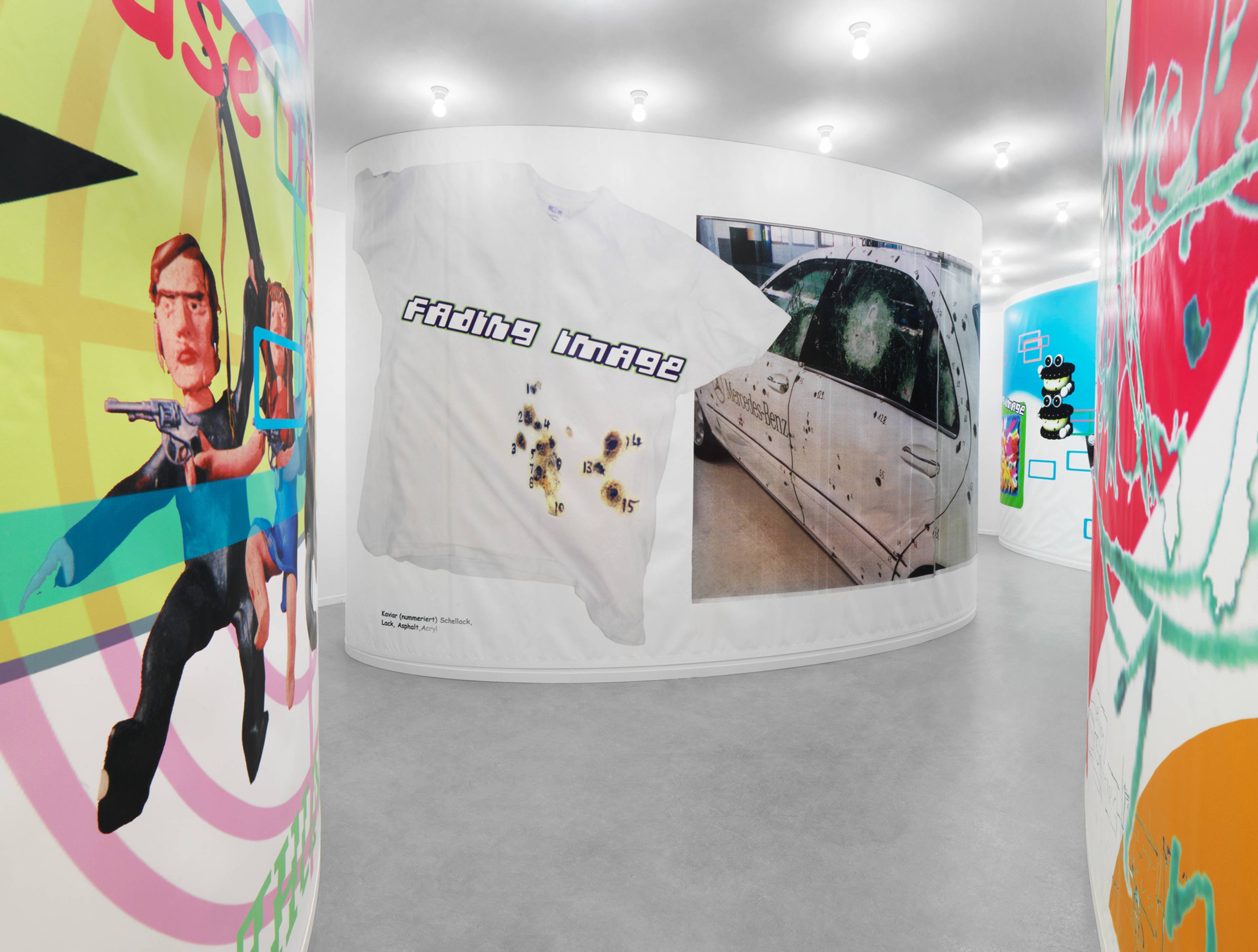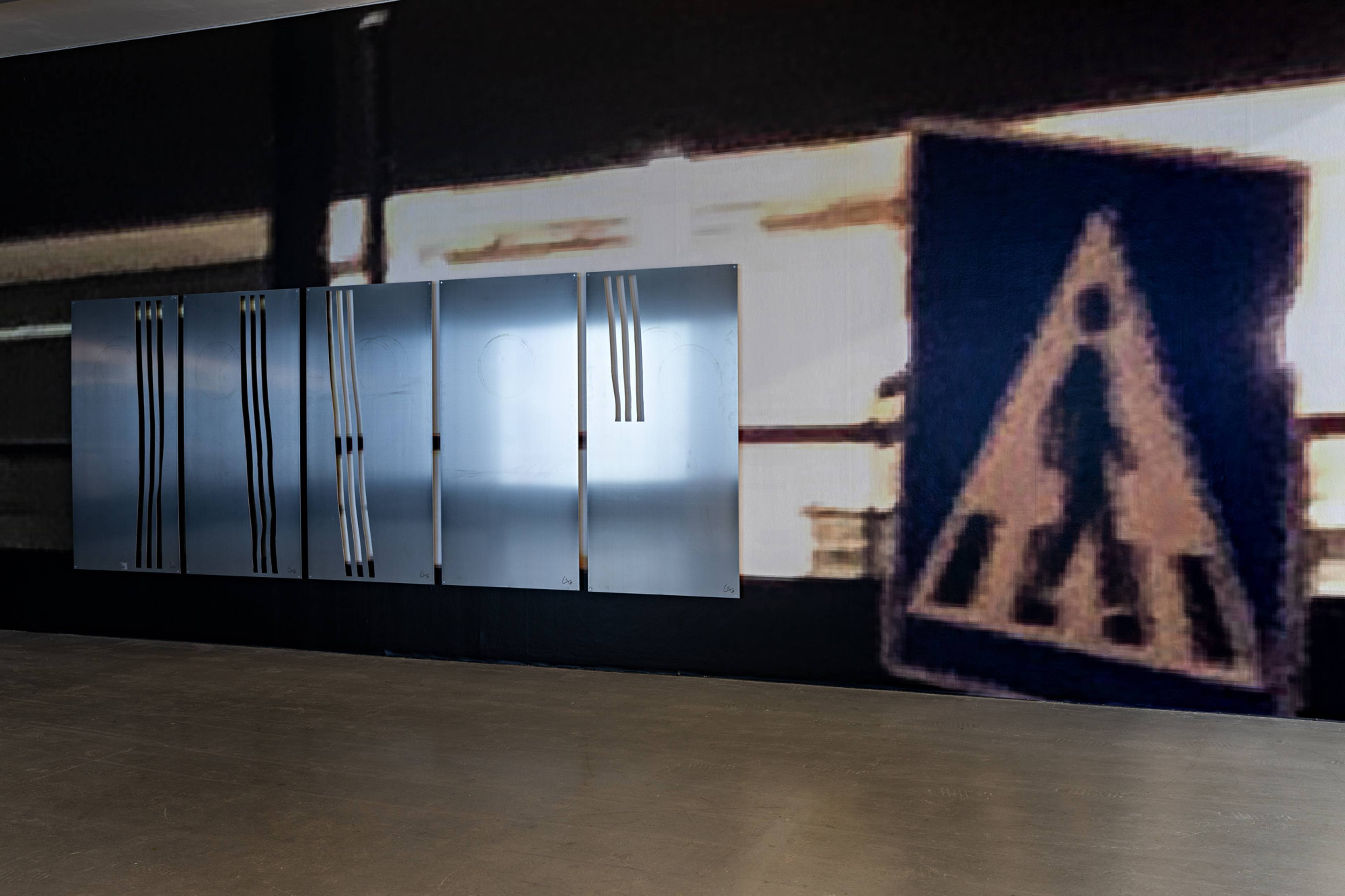How long could it possibly take to restart a laptop? In 2017, Cory Arcangel (*1978), an artist and musician best known for modding vintage media products – wiping everything but the cotton-ball clouds from Super Mario Brothers, or appending a glockenspiel to Bruce Springsteen’s too-sweet roadtrip fantasy Born to Run (1975) – got hold of the last Macbook of Michel Majerus (1967–2002). Working with the late painter’s estate and the new media art platform Rhizome, it took him seven years to get the computer back on – and he was floored by what he found. Majerus, who rendered an apex of cool by splicing the fonts, whitespace, and vectored logos of the early internet into a canonical, sometimes scornful grasp of 20th-century painting, turned out to be a fellow PC dweeb, as engrossed in Photoshop as in his brushes.
To milestone this miracle revival, Arcangel curated “Let’s Play Majerus G3,” a joint exhibition at the Michel Majerus Estate in Berlin marking the fourth paring of his work with that of his artistic crush. Besides drawing out the similarities in their interests and approaches, especially an antically bleak regard of nowness and its decay, the show has opened another chapter in the computer artist’s engagement with the Luxembourgish painter: a new series of tutorials on YouTube (where Arcangel has a substantial following) that, treating the resurrected laptop as an archaeological tool, intends to unpack a generational artistic talent the same way a guitar teacher would break down Van Halen – passionately, for anyone with a Web connection, one amazing run of notes at a time.
View of Michel Majerus, “zweihundertvier sechzigmalsechzig” [204 60 x 60], neugerriemschneider, Berlin, 2011. Photo: Jens Ziehe
Patrick Kurth: What was your formative experience with Michel Majerus?
Cory Arcangel: I first saw his work in New York when I was twenty-four, in the last show he did at Petzel Gallery [“Leuchtland,” 2002], then totally forgot about it. Ten years on, one of his later, untitled paintings – where he mixed fonts, color field painting, and abstraction – came across my Instagram feed. A kid who was working for me at the time had posted it from a show at Matthew Marks Gallery in New York. No name, no date, no information at all. When I saw it, I freaked – I didn’t know who it was, which didn’t happen often back then. My first thought was that it was a young Berlin artist that was sent to destroy me. At the time, I would have said I had never heard of Michel Majerus.
I eventually learned he had an estate, which was a surprise, because I thought the painting was new. I started trying to come to Berlin once a year, for no reason other than to learn more about him – I was just very attracted to the work. And flipping through the binders at the estate, I saw the space invader painting. I remembered it, then I remembered the Petzel show, and I remembered hating it! It had pushed all of my buttons, and seeing the painting reawakened these very powerful, lifelong feelings. But by that time, I’d been flying to his estate on my own dime for years, and my relationship to him had flipped.
Michel Majerus, Space Invaders 1, 2002, acrylic and silkscreen on cotton, 368 x 538 cm. © Michel Majerus Estate, 2024. Courtesy Kunstmuseum Bonn, permanent loan KiCo Collection. Photo: Jens Ziehe
PK: How did you get from visiting to working with the estate?
CA: I learned he had this laptop, and at some point, I had the idea to boot it up. After meeting in 2017 with the family, as well as with Tim Neuger and Burkhard Riemschneider, whose gallery represents the estate, we decided to try. And year after year, we’ve just been chipping away. It’s complicated technically, in part because there’s just not so many examples of this. But it’s also a sensitive topic, and a lot of the process was just talking about finding a way where everybody involved felt safe. Before I got access as a researcher, for example, the family removed all the personal and non-studio material.
Technically, Rhizome’s [preservation director] Dragan Espenschied brought in all the expertise to get the laptop running again. We only touched the physical artifact once, which was to take the hard drive out and copy it. When I say running again, it’s through a system Dragan is using called emulation as a service [EaaS] at the University of Freiburg. We can actually see Majerus’s computer as a window on my browser, with a kind of invisible “layer” over it of non-destructive editing possibilities. So, we’re able to remove things from the computer and save a copy and note what’s been removed while the original is preserved.
Screenshots of Michel Majerus’s laptop (PowerBook G3), selected by Cory Arcangel, November 2023
PK: Did you know what you were looking for at the outset?
CA: No. For six years, there was a very real possibility that the computer wouldn’t even boot up. In other words, I was happy with just doing the project as an exercise in karma. That was also a valid output of this project. But it turns out there is so much there – it was almost shocking to me how involved he was with his computer. He had a full stack: Adobe Premiere, Napster, Toast, Flash 4, After Effects, Cinema 4D, America Online – it’s every multimedia program you could have had at the time. More than I had, and I was pretty on it back then. It’s also a Macintosh G3 Wall Street, which was the highest end Apple of its day. It was basically the black Ferrari.
PK: How granular is the record of his laptop usage in EaaS?
CA: It’s exactly as he would have seen it the last time he closed the laptop. What’s so incredible about getting this computer to boot up again is that, even if the files could be accessed from a hard drive, you wouldn’t get any environmental data – creation data, modified data, where windows are positioned, what icons he’s using. Just looking at any of things is fascinating. For example, we can track his work flow via different creation dates. He’s working on this Texte zur Kunst edition, then you see photographs he took at an opening, then he’s working on this painting, then it’s three days off, maybe because he’s traveling. You can also see how he was doing layers in Photoshop: what things he was adding to a file, in what order, which ones he had taken away that were no longer part of the final work. There are so many files where you see him arranging paintings, especially in his series of 60 x 60 [cm] paintings. You can see all over the laptop that he really loved working in grids.
PK: How did you jump from archiving, not his art, but his art-making, to organizing a joint exhibition with his work?
CA: We wanted to somehow celebrate the project IRL. The first piece I requested was an edition he did for the Kölnischer Kunstverein [Lettin’ off as much as you can, 1997]. It’s very simple: just a painting, a pair of shoes, and a [Prodigy] CD. It stuck in my head from very early on in my research. I think his whole practice is compressed into this work: painting, the gesture, the hand, art history, fashion, anxiety about the present and the future, contemporary graphic design. He was paranoid that what looks good today may not look good tomorrow, but this work really looks like you could do this now.
That’s something that I’m also always playing with, and when I started with trying to select my own work, I knew I wanted something from my Alu series – something very severe, because this exhibition space has very, very bright lights. My work, ✎~|||.2023.060 [2023], is just a sheet of aluminum, with a black powder coating that emulates the look of anodization. The stripes are abstracted from a pair of Adidas that I laid on the floor of my studio and took the vectors of. It’s the most similar vibe I have to his.
Michel Majerus, Lettin’ off as much as you can, 1997, acrylic on canvas, sneaker, CD, 3 parts, canvas: 30 x 25,5 x 2.4 cm, sneakers in the buyer's size, CD: 12,5 x 14 x 1 cm. Edition of 6. © Michel Majerus Estate, 2024. Courtesy: private collection and neugerriemschneider, Berlin
Cory Arcangel, ✎~|||.2023.060, 2023, aluplate aluminum, powder coat thermo polymer, 150 x 150 x 0.6 cm. © Cory Arcangel, 2024. Courtesy: Lisson Gallery
I also always wanted to see these Brillo box works of his in person [A 1-7, T 1-7, H 1-7, M 1-7, 1996], and, in a kid-in-a-candy-shop way, we got one from the Kunsthalle Mannheim. They’re silkscreen on wood, the same as Warhol’s. I love this era of Majerus’s work, the late 90s, when things start to get very minimal, with a lot of white, similar to his aluminum paintings.
The next thing we included is my AUDMCRS Underground Dance Music Collection of Recorded Sound [2010–11]. It’s a collection of trance music from the late 90s and early 2000s that I bought in Brooklyn from the trance DJ Joshua Ryan. They weren’t worth anything, and I didn’t know what I was going do with them at first. But I had been waiting my whole life for a trance DJ to say, “Do you want to have a collection of trance records?” Eventually, I hired a team of professionals to photograph them and take down the metadata, all of which is available in an online archive. We even kept them in the original order. It tours as a sculpture or a readymade, and it’s also performed from time to time – Lena Willikens just DJed the collection at silent green in Berlin.
Michel Majerus, A 1-7, T 1-7, H 1-7, M 1-7, 1996, lacquer and silkscreen on wood, dimensions variable, 28 parts, 55 x 55 x 73 cm each. © Michel Majerus Estate, 2024. Courtesy: Kunsthalle Mannheim; donation by the Scharpff family, 2001
Cory Arcangel, The AUDMCRS Underground Dance Music Collection of Recorded Sound, 2011-2012, 839 trance-LPs, corresponding catalog in Machine-Readable Cataloging standard, listening station, latex gloves, dimensions variable. © Cory Arcangel, 2024. Courtesy: Lisson Gallery
PK: Why did you want to include the records here?
CA: He was so tuned in to the look of the age, and a lot of the techno fonts and record covers are actually mirrored exactly in his work. There’s an “E” on those boxes, for example, that you can find in the AUDMCRS, as well as Plastikman’s “Music” logo. I usually like to take things when they’re already a little bit dusty, whereas he dove right into the now – the work is totally of that present. But he was also so selective about what he was actually interested in, and it’s because he was able to get his work to such a high heat that it still looks so good today.
PK: What should we know about the Atari here?
CA: This [Space Invader, 2004] is a modified Atari 2600 cartridge. I had told my friend, Alex Galloway, wouldn’t it be funny if all the invaders were removed from Space Invaders except for one? He emailed me the code the next day, which is the version that’s on this chip; it’s almost impossible to play. He has no memory of it, but he says that, if I want to give him credit, he’ll take it!
Cory Arcangel, Space Invader, 2004, handmade hacked Space Invaders cartridge, Atari 2600 video game system, artist software (coded by Alex Galloway). © Cory Arcangel, 2024
PK: Was this your way of taking revenge on Majerus? Setting up the video game itself where Space Invaders could once have only appeared in the form of a painting?
CA: Well, when I saw his painting, I had already been working on a lot of game hacks and eight-bit programming, and I thought, why does this guy get to make these paintings when I’m working with the actual games? Why does he get to be shown in one of these beautiful spaces when a computer artist can’t? Fuck him! Because, at the time, media art didn’t have access to more trad contemporary spaces. And, of course, I wanted in. LOL.
But I also misunderstood his work. Because it wasn’t a cool painting of space invaders; it was a silkscreen that he made using the iconography of space invaders in the style of Warhol, just like this [pressure groups 3, 2002] is a painting in the style of Frank Stella, or Stella in the style of early Peter Halley. He was doing something I just didn’t recognize at the time; stealing the style of another artist was a pretty avant-garde move. Now, when I think back, it was actually pretty cool, because it turned out he also wanted in – I was looking at same the feelings that I had, even if he was able to do things that I could never imagine doing. It’s not so apparent from this show, but there’s a fluidity and improvisation, a visual knowledge and skill that he has that I don’t have access to.
Left to right: Michel Majerus, pressure groups 3, 2022; Cory Arcangel, Space Invader, 2004; and Cory Arcangel, The AUDMCRS Underground Dance Music Collection of Recorded Sound, 2011-2012. Installation view, Michel Majerus Estate, Berlin, 2024. © Michel Majerus Estate, 2024 © Cory Arcangel, 2024. Photo: Jens Ziehe
PK: How has your understanding of his work changed since gaining access to his digital studio?
CA: Before, I would have thought about him as “just” a contemporary artist and sculptor. Of course, it’s more complicated than that. His works perform as paintings and sculptures in the structure of the art world, so there’s also an institutional critique vibe. But, after doing so much research on his laptop, I think he’s actually a lot closer to me in terms of process than I thought. He’s sketching many of his works, designing whole shows, photoshopping his works into installation photos of empty galleries to see how his installations would photograph. For the early 2000s, that’s really advanced! So, he’s much more of a media artist than I had suspected. Or, he was moving in that direction; I’m moving the opposite way.
PK: What are you moving towards?
CA: I just want to be a painter and a sculptor. A normie contemporary artist. That’s my dream. Or, at least to be considered one.
The internet’s like a chronic disease that you have to manage, or else it will get out of control and ruin your life. That’s been hard for me to feel, because it was such a big part of my life for so long.
PK: What was in his artistic future if he hadn’t passed away?
CA: He was already moving into prints and things that have a more performative element. It’s a bit like how Warhol was such a good draftsman and spent his whole life trying to get away from his hand – I wonder if Majerus would have had the same issue trying to get away from how good he was at painting. But, it’s hard to say. The work is so good, I can’t imagine there being more of it.
PK: How did you approach making work for “Flying Foxes,” the 2022 show you did alongside his exhibition “Data Streaming” at the Kunstverein in Hamburg?
CA: I tried to make works that played off his energy. The vibe I get from his work is really dystopian. It’s a little bit hard to piece together in this show because the work is so bright and colorful and fun – people say the same about my work – but just look at the text in this painting: “Your ideas get you killed.” This is Western civilization in a capsule now. There are really beautiful things about it, but it’s also rubber, plastic, fast fashion, throwaways, Disney, viruses …
Views of Michel Majerus, “Data Streaming,” Kunstverein in Hamburg, 2022–23
© Kunstverein in Hamburg. Photos: Jens Ziehe
Views of Cory Arcangel, “Flying Foxes,” Kunstverein in Hamburg, 2022–23
© Kunstverein in Hamburg. Photos: Fred Dott
PK: Your work has been deeply involved with web technologies for two decades. How do you use the internet in 2024?
CA: I only have access to the internet, or what we would describe as the internet – meaning a browser and social media – at my office. I use it to work, and I have a bit of a media diet, basically Substack and Arena. But I don’t bring any of it home anymore, and my phone is just bank apps, a calendar, messages, and Duo Lingo – that’s the only thing that I’m allowed to do! Instagram? I could just never get off it. TikTok’s even worse for me. The internet’s like a chronic disease that you have to manage, or else it will get out of control and ruin your life. That’s been hard for me to feel, because it was such a big part of my life for so long.
PK: What’s your interest in the laptop going forward?
CA: I want to communicate an enthusiasm – and maybe this is going sound really corny – but I have an enthusiasm for contemporary art. I love this game. With all of the drawbacks of the industry, the actual purified part of it, like the Majerus sculptures in the show – I love this stuff! And I want to communicate this enthusiasm to as large an audience as possible, including, hopefully, to many people who have no in to it at all. You know, some kid in Iowa or something.
This laptop, because it’s essentially a studio, has a lot of behind-the-scenes of how Majerus’s works got made. I think YouTube is a great educational medium: I love that I can watch guitar YouTubers say, let’s look at the run of notes in this Eddy Van Halen solo and talk about why it’s amazing. I’m making these video tutorials because I think I can do the exact same thing here for a contemporary artist, and to try to communicate it in the exact same way. It’s been a pet peeve of mine for so many years that there isn’t a lot of great contemporary art content on YouTube, and I finally decided to do something about it. Contemporary art is really great, and it just shouldn’t be intimidating.
Cory Arcangel. Photo: Tim Barber
___
“Let’s Play Majerus G3”: A Project by Cory Arcangel
Michel Majerus Estate, Berlin
27 Apr 2024 – 15 Mar 2025


